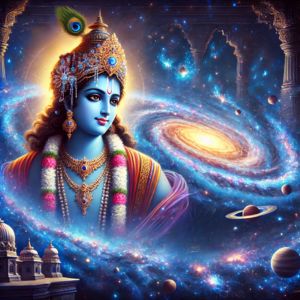The Divine Play of Creation in Sanatana Dharma

Sanatana Dharma offers profound insights into the nature of the universe, the purpose of life, and the role of the divine. Central to this understanding is the concept of the Supreme God, often referred to as Narayana or Vishnu, who is both the creator and the sustainer of the cosmos. This philosophy explains the universe's existence as a divine play, providing opportunities for souls to realize their true nature and attain liberation.
Understanding the Supreme God
In our thought, the Supreme God is the source and essence of everything. He is eternal, unchanging, and beyond human comprehension. The Vedas and Upanishads describe Him as 'Sarvopari' – the One who is above all. He is not just a distant observer but actively involved in the universe's creation, maintenance, and dissolution. This belief is central to understanding the world around us and our place within it.
Example from Scriptures: In the Bhagavad Gita, Krishna states, 'I am the origin of all creation; everything emanates from Me.' This highlights the belief that the Supreme God is the root cause of all existence, and nothing happens without His will.
The Purpose of Creation
Sanatana Dharma sees the universe not as a random occurrence but as a purposeful act of creation. The world exists for two main reasons: for the Supreme God to express His divine nature and for souls (Jivas) to realize their spiritual potential. The universe is like a grand stage, where souls can act, learn, and evolve.
Creation is described as a 'Lila,' or divine play. The Supreme God, being perfect and self-sufficient, does not need the universe for His fulfillment. Instead, the universe exists as a manifestation of His joy and creativity. This divine play allows for the expression of His various attributes, such as compassion, wisdom, and power.
The Journey of the Soul
According to Hindu teachings, every soul is inherently divine but is covered by layers of ignorance (Avidya). The purpose of life is to remove these layers and realize the soul's true nature, which is eternal, blissful, and pure. The journey toward self-realization involves various spiritual practices, including devotion (Bhakti), knowledge (Jnana), and righteous action (Karma).
Scriptural Insight: The Upanishads often use metaphors to explain the soul's journey. One such metaphor is that of a charioteer guiding a chariot, where the soul is the rider, the body is the chariot, the intellect is the charioteer, and the senses are the horses. This metaphor illustrates that controlling the senses and mind through wisdom and discipline leads the soul to its ultimate destination – union with the divine.
Manifestations of the Divine Feminine
In addition to the Supreme God, Sanatana Dharma recognizes the importance of the divine feminine, often represented by Goddess Lakshmi. She is not only the goddess of wealth and prosperity but also embodies grace, compassion, and the nurturing aspects of the divine. Lakshmi takes on various forms to fulfill the needs of the universe and support the creation process.
Lakshmi's role in creation shows that divine power is not limited to a single entity. Instead, it operates through various forms and functions, each contributing to the cosmic balance. Whether manifesting as Sita in the Ramayana or Rukmini in the Bhagavata, Lakshmi symbolizes different facets of divine love and support, helping souls on their spiritual journey.
Liberation: The Ultimate Goal
The ultimate aim of creation, as taught in Sanatana Dharma, is to provide a path for souls to achieve liberation (Moksha). Liberation is the state of freedom from the cycle of birth and death, where the soul merges with the Supreme God in eternal bliss and knowledge. This state is considered the highest form of existence, free from suffering and ignorance.
To attain liberation, the soul must transcend material desires and attachments. This is achieved through spiritual practices, selfless actions, and devotion to the divine. The teachings of Hindu scriptures consistently emphasize the importance of surrendering to the Supreme God and seeking His grace for liberation.
In the Bhagavad Gita, Krishna assures, 'Those who surrender unto Me, I swiftly deliver from the ocean of birth and death.' This highlights the importance of devotion and surrender in achieving the ultimate goal of liberation.
The Role of Free Will and Divine Grace
While the universe operates according to divine will, Sanatana Dharma also acknowledges the role of free will. Souls are given the freedom to choose their actions, which shapes their journey and experiences. This concept of free will is crucial because it empowers individuals to take charge of their spiritual growth and make conscious choices toward their ultimate goal.
At the same time, divine grace plays a pivotal role in the soul's journey. It is believed that the Supreme God, out of His boundless compassion, provides guidance, support, and opportunities for souls to evolve. This balance between free will and divine grace creates a dynamic interplay that defines the human experience.
Conclusion
In Sanatana Dharma, the universe is more than just a physical reality; it is a manifestation of divine will and purpose. The Supreme God, Narayana, creates and sustains the cosmos not out of necessity but as an expression of His infinite joy and creativity. This divine play offers souls the opportunity to realize their true nature and attain liberation.
By understanding these teachings, one can gain a deeper appreciation of life's purpose and the divine presence within and around us. It encourages us to live a life of righteousness, devotion, and wisdom, aligning ourselves with the cosmic order and progressing toward the ultimate goal of liberation.

English
Rare Topics
Click on any topic to open
7
30
Astrology
Atharva Sheersha
Bhagavad Gita
Bhagavatam
Bharat Matha
Devi
Devi Mahatmyam
Ganapathy
Glory of Venkatesha
Hanuman
Kathopanishad
Mahabharatam
Mantra Shastra
Mystique
Practical Wisdom
Purana Stories
Radhe Radhe
Ramayana
Rare Topics
Rituals
Rudram Explained
Sages and Saints
Shiva
Spiritual books
Sri Suktam
Story of Sri Yantra
Temples
Vedas
Vishnu Sahasranama
Yoga Vasishta